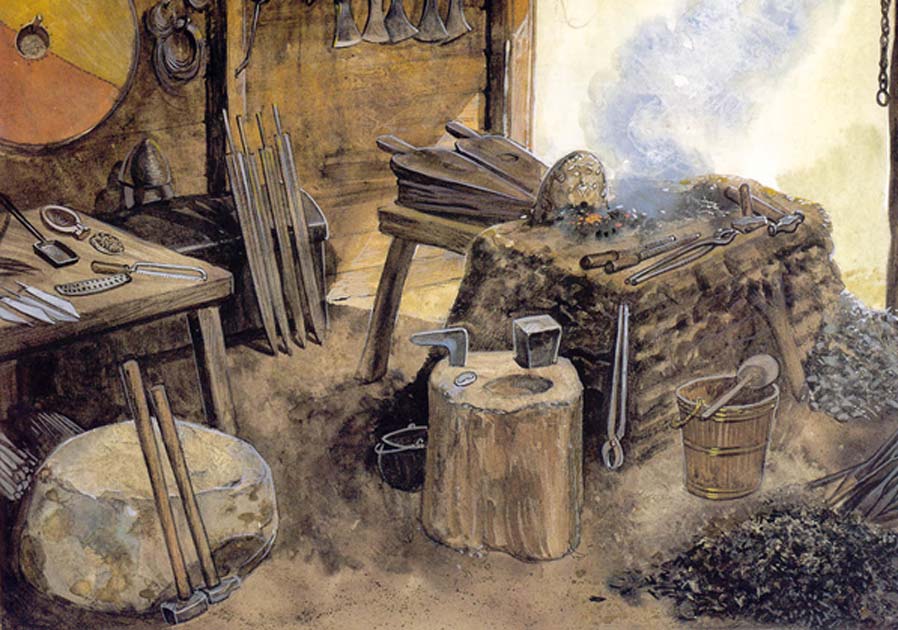Viking Camp Complete with Ship Building and Weapon Workshops Unearthed in England
The craftsmanship and shipbuilding capabilities of the Vikings are often overshadowed by stereotypical images of violent invaders, plunderers, and explorers. But it is worthwhile to remind ourselves that there were everyday aspects to the lives of the Norse men and women as well. Discoveries like recent excavations in Derbyshire help us reflect on the oft-forgotten skills of Vikings away from their homeland.
A press release by the University of Bristol says that the Viking winter campsite from 873-874 has been known about in the village of Repton since 1975. However, the recent excavations by a team of University of Bristol archaeologists has exposed a larger area for the site to include sections used as workshops and for ship repairs.

A Viking ship. ( The-Wanderling)
According to the Daily Mail, ground penetrating radar revealed pathways and gravel platforms which were probably used as the foundations for tents or temporary timber buildings. One of the paths led to a mass grave site inside a deliberately damaged Saxon building which was discovered in the 1980s. New radiocarbon dating of a sample of the almost 300 people suggests that these are the remains of warriors who died in battle around the time of the camp’s usage. The team also noted that the building which housed the dead had once been used for a workshop.
- Archaeologists Uncover Evidence of Huge Viking Camp in England
- You Speak Like a Viking! 10 Everyday Words in English with Old Norse Origins
Regarding artifacts, the archaeologists found some lead game pieces at the Viking camp. Broken pieces of weapons such as arrows and battle axes suggest that metal working took place at the site and Viking ship nails provide a clear indication for repairs likely taking place there as well.


Top: Fragment of axe-head found in association with Viking camp material. Bottom: Arrowhead found in association with Viking camp material. (Cat Jarman, University of Bristol)
Speaking on the site, Cat Jarman, a PhD student at the University of Bristol, said:
“Our dig shows there was a lot more to the Viking Camp at Repton than what we may have thought in the past. It covered a much larger area than was once presumed – at least the area of the earlier monastery – and we are now starting to understand the wide range of activities that took place in these camps.”

Stamps showing ‘Everyday Life in the Viking Age.’ ( Public Domain )
The existence of the Viking winter camp was documented in the Anglo-Saxon Chronicle. It mentions the ‘Great Army’ annexing the kingdom of the Mercian king Burghred in 873. In fact, it has been argued that part of the reason that location was chosen for the camp was due to the nearby monastery which held the bodies of Mercian kings. The closeness to the river Trent would have also played a role.
The results of the excavations will be presented on the BBC Four series ‘Digging for Britain’ on November 22.

Students excavating the winter camp. (Cat Jarman, University of Bristol)
Vikings are certainly a hot topic these days. Dramas such as Vikings (History Channel) and The Last Kingdom (BBC) have propelled an interest in the Norsemen to a new generation. Despite their popularity, there is much that people still misunderstand about the Viking age and its people. As Mark Miller reflected in a previous Ancient Origins article, a recent survey of 2,000 people in the UK shows,
“many British people are clueless about the Vikings. In fact, 20 percent didn’t even know Vikings were from Scandinavia. And 10 percent think the Viking Age happened much later, mistakenly thinking from the 15th to 18th centuries. Another 25 percent did not know the Vikings attacked the British Isles, instead thinking they raided South America.”
- Survey Shows About Half of Brits Wish They Were Descended from Vikings…and Many Probably Are!
- First Genetic Proof of a Viking Age Warrior Woman is Identified from an Iconic Swedish Grave

Danes invading England. From "Miscellany on the life of St. Edmund," 12th century. (Public Domain)
A popular error regarding the appearance of a Viking is the 19th century myth of the Viking horned helmet. This stereotypical image has been traced to the 1800s, when Gustav Malmström, a Swedish artist, and Wagner’s opera costume designer Carl Emil Doepler both decided to depict Vikings in horned helmets. In contrast, depictions of warriors from the Viking age show them in iron or leather helmets, if they are even wearing the headgear at all.

A stereotypical painting by Mary McGregor from 1908 of Leif Ericson landing at Vinland ( Public Domain )
Top Image: A Viking weapon workshop. Credit: Kevin Roddy

















